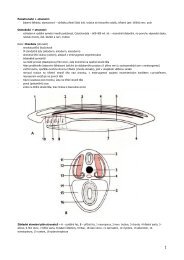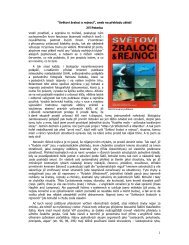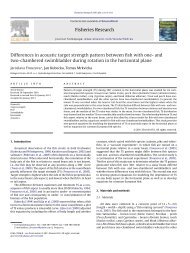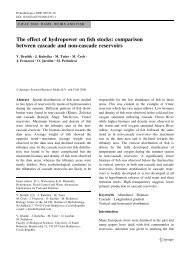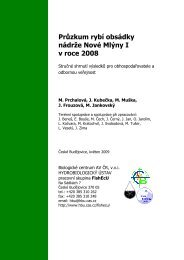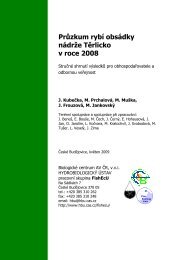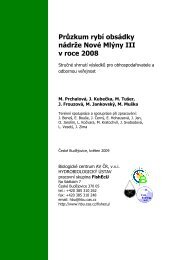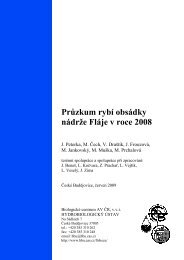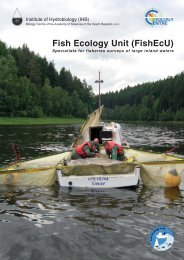Fisheries Research Fish sampling with active methods
Fisheries Research Fish sampling with active methods
Fisheries Research Fish sampling with active methods
You also want an ePaper? Increase the reach of your titles
YUMPU automatically turns print PDFs into web optimized ePapers that Google loves.
<strong><strong>Fish</strong>eries</strong> <strong>Research</strong> 123–124 (2012) 1–3<br />
Contents lists available at SciVerse ScienceDirect<br />
<strong><strong>Fish</strong>eries</strong> <strong>Research</strong><br />
jou rn al hom epage: www.elsevier.com/locate/fishres<br />
Editorial<br />
<strong>Fish</strong> <strong>sampling</strong> <strong>with</strong> <strong>active</strong> <strong>methods</strong><br />
a r t i c l e i n f o<br />
Keywords:<br />
<strong>Fish</strong> stock assessment<br />
Active and passive gear<br />
Intercalibration<br />
Standardization<br />
Accuracy<br />
Ground truthing<br />
Interpretation<br />
Selectivity<br />
Avoidance<br />
a b s t r a c t<br />
The conference ‘<strong>Fish</strong> Sampling <strong>with</strong> Active Methods’ (FSAM) was held in September 2010 in Ceske Budejovice,<br />
Czech Republic. A total of 108 participants from 29 countries attended the meeting and 100 lectures<br />
and posters were presented. The meeting brought together scientist working <strong>with</strong> an interesting combination<br />
of techniques for investigation of fish populations in seas, lakes, reservoirs and rivers (mostly<br />
hydroacoustics, trawling, electric fishing, comparison of <strong>active</strong> <strong>methods</strong> <strong>with</strong> the use of gillnets and use<br />
of visual approaches). In contrast to passive <strong>methods</strong>, <strong>active</strong> <strong>methods</strong> can be used to measure absolute<br />
fish abundance because the <strong>sampling</strong> volume can be defined and estimated. If fish welfare precautions<br />
are applied, <strong>active</strong> <strong>methods</strong> can be less destructive than passive. But there is still a need for using combinations<br />
of multiple <strong>sampling</strong> <strong>methods</strong> and for improved understanding of gear efficiency, scrutinizing<br />
the efficiency through independent <strong>methods</strong> or by studying of variation in <strong>sampling</strong> efficiency due to the<br />
robustness of the <strong>sampling</strong> strategy (comparing the nets of different dimensions, mesh sizes, speed etc.).<br />
© 2011 Published by Elsevier B.V.<br />
The international conference <strong>Fish</strong> Sampling <strong>with</strong> Active Methods<br />
was held September 8–11, 2010 in the Biology Centre, Academy<br />
of Sciences of the Czech Republic, České Budějovice. Over one hundred<br />
participants from 29 countries presented 63 oral and 37 poster<br />
communications. This conference was a followup of an earlier<br />
meeting (<strong>Fish</strong> Stock Assessment Methods for Lakes and Reservoirs:<br />
Towards the True Picture of <strong>Fish</strong> Stock) held at the same location<br />
September 11–15, 2007 (published as a special issue of <strong><strong>Fish</strong>eries</strong><br />
<strong>Research</strong>, Kubečka et al., 2009). A true picture of the fish present<br />
in the sea, lake or river can only be obtained if we understand the<br />
efficiency of our various <strong>methods</strong> for <strong>sampling</strong> different fish species<br />
and size groups. Although <strong>active</strong> gear may be more difficult to operate<br />
than passive gear, these <strong>methods</strong> often provide a “truer” picture<br />
of species composition and size structure, and have the potential<br />
to provide absolute abundance. Continued development of <strong>active</strong><br />
<strong>sampling</strong> gear is important for improving our ability to provide a<br />
realistic picture of fish stocks. The papers in this special issue on<br />
fish <strong>sampling</strong> <strong>with</strong> <strong>active</strong> <strong>methods</strong> are a contributing to this goal.<br />
1. Structure of the meeting<br />
Active <strong>sampling</strong> is used in both marine and freshwater fisheries<br />
research and the problems associated <strong>with</strong> <strong>active</strong> <strong>sampling</strong><br />
are similar across systems. This meeting provided a forum for<br />
marine and freshwater scientists to meet and discuss these common<br />
problems, including topics such as gear avoidance, <strong>sampling</strong><br />
efficiency, replicability, standardization, and gear comparisons. The<br />
meeting was divided into sessions covering <strong>sampling</strong> <strong>with</strong> electrofishing<br />
gear, trawls, seines, larval fish nets, visual <strong>methods</strong> and<br />
acoustics (Table 1). Many presentations compared different <strong>sampling</strong><br />
<strong>methods</strong>, including comparisons between <strong>active</strong> and passive<br />
gears. In marine environments, the three main approaches investigated<br />
were trawling, acoustics and visual <strong>methods</strong>. These <strong>methods</strong><br />
were also discussed in the freshwater presentations, but freshwater<br />
<strong>methods</strong> also included electrofishing, which is much less applicable<br />
in salt water. Acoustic applications were used in larger waters,<br />
typically seas, lakes and reservoirs, while electrofishing most often<br />
applied to small wadeable streams. We also noted an increased<br />
attention to trawling in freshwater surveys. Other <strong>active</strong> <strong>methods</strong><br />
discussed in both marine and freshwater studies included hand and<br />
cast nets, use of commercial fishers, explosives, and toxicants. In<br />
addition comparisons were made <strong>with</strong> passive gear such as longlines,<br />
gillnets and traps (Table 2).<br />
2. Active and passive <strong>sampling</strong> gear<br />
The distinction between <strong>active</strong> and passive fishing gear is important.<br />
Efficiency of <strong>sampling</strong> <strong>with</strong> passive gear depends on the<br />
activity of the fish to encounter the gear and the retention probability<br />
once a gear has been encountered (Hamley, 1975; Rudstam<br />
et al., 1984; He and Pol, 2010) – <strong>Fish</strong> activity most certainly varies<br />
Table 1<br />
The numbers of oral and poster lectures in individual sections of the conference.<br />
Section Oral lectures Posters Total<br />
Large rivers, estuaries 6 1 7<br />
Streams and electrofishing 8 5 13<br />
Trawling 14 6 20<br />
Seining 5 4 9<br />
Small fish <strong>sampling</strong> 7 2 9<br />
Commercial fishing issues 2 2 4<br />
Visual <strong>methods</strong> 5 4 9<br />
Acoustics 12 7 19<br />
Standardization 4 3 7<br />
Combination of <strong>methods</strong> 3 3<br />
Total 63 37 100<br />
01657836/$ – see front matter © 2011 Published by Elsevier B.V.<br />
doi:10.1016/j.fishres.2011.11.013
2 Editorial / <strong><strong>Fish</strong>eries</strong> <strong>Research</strong> 123–124 (2012) 1–3<br />
Table 2<br />
Absolute and relative frequencies of different gear scrutinized in conference<br />
contributions.<br />
Gear<br />
Marine<br />
systems<br />
Freshwater<br />
systems<br />
% of total<br />
Acoustic surveys 23.6 22.2 22.8<br />
Trawling 27.3 16.7 20.7<br />
Electrofishing 0.0 21.1 13.1<br />
Gillnets 10.9 14.4 13.1<br />
Seining 7.3 11.1 9.7<br />
Visual surveys 18.2 3.3 9.0<br />
Traps 1.8 6.7 4.8<br />
Hand and cast nets 3.6 3.3 3.4<br />
Explosives/toxicants 1.8 1.1 1.4<br />
Longlines 3.6 0.0 1.4<br />
Industry information 1.8 0.0 0.7<br />
Total number of comparisons 55 90 147<br />
<strong>with</strong> season, time of day, species, size, sex and even the physiological<br />
state of an individual fish. Active gear on the other hand relies on<br />
the movement of the gear rather than the fish, although fish behavior<br />
is still important as fish may avoid the gear or the boat, and<br />
may escape the gear after encounter (as discussed in Winger et al.,<br />
2010; Rakowitz et al., in this issue). Active <strong>methods</strong> are likely more<br />
efficient when fish are in<strong>active</strong> (often at night) whereas passive<br />
<strong>methods</strong> are more efficient when the fish are <strong>active</strong> (often during<br />
dusk and dawn or the spawning period). Complexity is added<br />
to this picture by the modifying effects of diel patterns in habitat<br />
choice by different fish species. This also determines when they are<br />
vulnerable to a particular gear.<br />
Another advantage of <strong>active</strong> <strong>sampling</strong> <strong>methods</strong> is that the <strong>sampling</strong><br />
volume can often be defined (area or volume swept by a trawl,<br />
area covered by electrofishing, volume insonified by acoustics). For<br />
passive gear, we are usually limited to correlations of catch per<br />
unit effort (CPUE) <strong>with</strong> some measure of population size and such<br />
correlations are often lake specific (e.g. Irwin et al., 2008). More<br />
comparisons of CPUE of passive gears <strong>with</strong> absolute density or<br />
biomass estimated using <strong>active</strong> <strong>methods</strong> would be valuable given<br />
the increased use of standardized gill nets for fish community surveys<br />
in both North America and Europe. When properly operated,<br />
<strong>active</strong> and passive <strong>sampling</strong> <strong>methods</strong> represent two “true” but different<br />
pictures of the target stock or ecosystem, like pictures of<br />
an object from different angles. The move towards <strong>methods</strong> giving<br />
absolute estimates depends both on appropriate spatiotemporal<br />
coverage as well as reliable ways of combining information from<br />
various gears. Several meeting presentations demonstrated that<br />
a steadily improving technology prepares the ground for future<br />
developments in this direction.<br />
The destructiveness of the <strong>sampling</strong> gear to fish and habitat is<br />
another cause for concern. This is gearspecific and not related to<br />
whether the gear is passive or <strong>active</strong>. Passive traps can be very fishfriendly<br />
while fish caught by gillnets and longlines seldom survive.<br />
When fish welfare is receiving appropriate care, the survival from<br />
the catch of <strong>active</strong> gear (trawls and electrofishing) can be good<br />
(Jurvelius et al., 2000; Broadhurst et al., 2006; Gatz and Linder,<br />
2008), although trawl catches are often lethal and bottom trawls<br />
can damage the sampled habitat (Watling and Norse, 1998). The<br />
conference audience clearly indicated a move from highly destructive<br />
<strong>active</strong> approaches like the use of toxicants and explosives<br />
towards nonintrusive <strong>methods</strong> like acoustic, visual and photographic<br />
techniques (Table 2).<br />
3. Perspectives<br />
Many of the contributions confirmed that obtaining “the true<br />
picture of the fish stock” (a notion introduced in the preceding conference<br />
FSAMLR; Kubečka et al., 2009) is the goal of fish <strong>sampling</strong>,<br />
although an elusive one. With the need to develop an ecosystem<br />
approach to the fisheries management (FAO, 2003) comes a need<br />
to obtain absolute information on fish quantity, species and age<br />
distribution. In many cases we are not yet satisfied <strong>with</strong> the representativeness<br />
of the information collected. Comparing several<br />
different <strong>sampling</strong> <strong>methods</strong> is important but suffers from a lack<br />
of ground truth information (Axenrot et al., 2010; Emmrich et al.,<br />
2010; Draštík et al., 2010). Rarely is the true status of the fish stock<br />
known during <strong>sampling</strong>, but see Godlewska et al. (in this issue)<br />
for a comparison of <strong>active</strong> <strong>sampling</strong> <strong>with</strong> a complete enumeration<br />
of fish after draining the waterbody. Another very promising<br />
approach is to scrutinize the efficiency of <strong>sampling</strong> using independent<br />
remote <strong>methods</strong> like optical or acoustical cameras (Winger<br />
et al., 2010; Handegaard, 2010; Rakowitz et al., in this issue). Such<br />
approaches can lead to an understanding of the species and size<br />
specific catchabilities of the gear in question. Increasing efficiency<br />
of a single <strong>sampling</strong> method and comparing the estimates obtained<br />
<strong>with</strong> the improved and earlier <strong>methods</strong> are also valuable (Jůza et al.,<br />
in this issue; Baldwin and Aprahamian, in this issue). When further<br />
increase in net dimensions, towing speed, and/or change of mesh<br />
sizes fail to increase catches, it may be assumed that the asymptotic<br />
catch rates are obtained <strong>with</strong> 100% efficiency.<br />
This meeting invited contribution from both marine and fresh<br />
water ecosystems. Differences in approaches and <strong>methods</strong> were<br />
well demonstrated, and the obvious mutual benefit from comparison<br />
and interaction between them was enlightened. The smaller<br />
water bodies in fresh water system permit controlled ecological<br />
experimentation that is unrealistic in the ocean. The extensive<br />
research in fishing and acoustic gear technologies taking in place in<br />
the marine environment can easily be made available for freshwater<br />
research. Both issues would benefit from extended interaction<br />
between the two scientific communities.<br />
Obtaining reliable data on fish stocks remains an extremely difficult<br />
task especially in larger waters (seas, large rivers, lakes and<br />
reservoirs). However, fisheries scientists are making progress in<br />
this direction thanks to new developments in <strong>sampling</strong> and validation<br />
technology. There is no method that suites all fish species<br />
and sizes but improved understanding of the efficiency of various<br />
<strong>methods</strong> will lead to better choices of the complement of <strong>methods</strong><br />
required to get a true picture of the fish stock. This meeting<br />
represents a step forward towards this goal.<br />
References<br />
Axenrot, T., Sandström, A., Asp, A., Setzer, M., 2010. Can gillnetting data improve<br />
accuracy and precision in hydroacoustic estimates of fish abundance? In:<br />
Kubečka, J., Hohausová, E., Soukalová, K. (Eds.), <strong>Fish</strong> Sampling <strong>with</strong> Active Methods,<br />
Book of abstracts. Biology Centre AS CR, 3.<br />
Baldwin, L., Aprahamian, M. An evaluation of electric fishing for stock assessment<br />
of resident eel in rivers. <strong><strong>Fish</strong>eries</strong> <strong>Research</strong>, in this issue.<br />
Broadhurst, M.K., Suuronen, P., Hulme, A., 2006. Estimating collateral mortality<br />
from towed fishing gear. <strong>Fish</strong> and <strong><strong>Fish</strong>eries</strong> 7, 180–218, doi:10.1111/j.1467<br />
2979.2006.00213.x.<br />
Draštík, V., Kubečka, J., Čech, M., Frouzová, J., Říha, M., Jůza, T., Tušer, M., Muška,<br />
M., Prchalová, M., Peterka, J., Vašek, M., Kratochvíl, M., 2010. Intercalibration<br />
between hydroacoustics and gillnet <strong>sampling</strong> in temperate reservoirs. In:<br />
Kubečka, J., Hohausová, E., Soukalová, K. (Eds.), <strong>Fish</strong> Sampling <strong>with</strong> Active Methods,<br />
Book of abstracts. Biology Centre AS CR, 21.<br />
Emmrich, M., Helland, I.P., Busch, S., Schiller, S., Mehner, T., 2010. Hydroacoustic<br />
estimates of fish densities in comparison <strong>with</strong> stratified pelagic trawl <strong>sampling</strong><br />
in two deep, coregoniddominated lakes. <strong><strong>Fish</strong>eries</strong> <strong>Research</strong> 105, 178–186,<br />
doi:10.1016/j.fishres.2010.05.001.<br />
FAO, 2003. The ecosystem approach to fisheries. FAO Technical Guidelines for<br />
Responsible <strong><strong>Fish</strong>eries</strong>. No. 4, Suppl. 2. Rome: FAO. 2003. 112 pp.<br />
Gatz, A.J., Linder, R.S., 2008. Effects of repeated electroshocking on condition, growth,<br />
and movement of selected warmwater stream fishes. North American Journal<br />
of <strong><strong>Fish</strong>eries</strong> Management 28, 792–798, doi:10.1577/M07031.1.<br />
Godlewska, M., Frouzova, J., Kubecka, J., Wiśniewolski, W., Szlakowski, J. Comparison<br />
of hydroacoustic estimates <strong>with</strong> fish census in shallow Malta reservoir – which<br />
TS/L regression to use in horizontal beam applications? <strong><strong>Fish</strong>eries</strong> <strong>Research</strong>, in<br />
this issue.
Editorial / <strong><strong>Fish</strong>eries</strong> <strong>Research</strong> 123–124 (2012) 1–3 3<br />
Hamley, J.M., 1975. Review of gillnet selectivity. Journal of the <strong><strong>Fish</strong>eries</strong> <strong>Research</strong><br />
Board of Canada 32, 1943–1969.<br />
Handegaard, N.O., 2010. Fitting observed fish trajectories to catchability models.<br />
In: Kubečka, J., Hohausová, E., Soukalová, K. (Eds.), <strong>Fish</strong> Sampling <strong>with</strong> Active<br />
Methods, Book of abstracts. Biology Centre AS CR, 28.<br />
He, P., Pol, M., 2010. <strong>Fish</strong> behaviour near gillnets: capture processes and influencing<br />
factors. In: He, P. (Ed.), Behaviour of Marine <strong>Fish</strong>es. WileyBlackwell, Ames, Iowa,<br />
USA, pp. 205–236.<br />
Irwin, B.J., Treska, T.J., Rudstam, L.G., Sullivan, P.J., Jackson, J.R., VanDeValk, A.J.,<br />
Forney, J.L., 2008. Estimating walleye (Sander vitreus) density, gear catchability,<br />
and mortality using three fisheryindependent data sets for Oneida Lake,<br />
New York. Canadian Journal of <strong><strong>Fish</strong>eries</strong> and Aquatic Sciences 65, 1366–1378,<br />
doi:10.1139/F08062.<br />
Jurvelius, J., Riikonen, R., Marjomaki, T.J., Lilja, J., 2000. Mortality of pikeperch (Stizostedion<br />
lucioperca), brown trout (Salmo trutta) and landlocked salmon (Salmo<br />
salar m. sebago) caught as bycatch in pelagic trawling in a Finnish lake. <strong><strong>Fish</strong>eries</strong><br />
<strong>Research</strong> 45, 291–296, doi:10.1016/S01657836(99)001162.<br />
Jůza,T. Čech, M., Kubečka, J., Vašek, M., Peterka, J., Kratochvíl, M., Frouzová, J., Matěna,<br />
J. The influence of the trawl mouth opening size and net colour on catch efficiency<br />
during <strong>sampling</strong> of early stages of perch (Perca fluviatilis) and pikeperch<br />
(Sander lucioperca) in the bathypelagic layer of a canyonshaped reservoir. <strong><strong>Fish</strong>eries</strong><br />
<strong>Research</strong>, in this issue.<br />
Kubečka, J., Amarasinghe, U.S., Bonar, S.A., Hateley, J.A., Hickley, P., Hohausová, E.,<br />
Matěna, J., Peterka, J., Suuronen, P., Tereschenko, V., Welcomme, R., Winfield, I.J.,<br />
2009. The true picture of a lake or reservoir fish stock: a review of needs and<br />
progress. <strong><strong>Fish</strong>eries</strong> <strong>Research</strong> 96, 1–5, doi:10.1016/j.fishres.2008.09.021.<br />
Rakowitz G., Tušer M, Řiha M., Jůza T., Balk H., Kubečka J. Use of highfrequency<br />
imaging sonar to observe fish behaviour <strong>with</strong> respect to an <strong>active</strong> surface trawl.<br />
<strong><strong>Fish</strong>eries</strong> <strong>Research</strong>, in this issue.<br />
Rudstam, L.G., Magnuson, J.J., Tonn, W.T., 1984. Size selectivity of passive fishing<br />
gear: a correction for encounter probability applied to gill nets. Canadian Journal<br />
of <strong><strong>Fish</strong>eries</strong> and Aquatic Sciences 41, 1252–1255.<br />
Watling, L., Norse, E.A., 1998. Disturbance of the seabed by mobile fishing gear:<br />
a comparison to forest clearcutting. Conservation Biology 12, 1180–1197,<br />
doi:10.1046/j.15231739.1998.0120061180.x.<br />
Winger, P.D., Eayrs, S., Glass, C.W., 2010. <strong>Fish</strong> behaviour near bottom trawls. In:<br />
He, P. (Ed.), Behaviour of Marine <strong>Fish</strong>es. WileyBlackwell, Ames, Iowa, USA, pp.<br />
205–236.<br />
Jan Kubečka ∗<br />
Biology Centre of the Academy of Sciences of the<br />
Czech Republic, v.v.i., Institute of Hydrobiology, Na<br />
Sádkách 7, 370 05 České Budějovice, Czech Republic<br />
Olav Rune Godø<br />
Institute of Marine <strong>Research</strong>, P. O. Box 1870 Nordnes,<br />
5817 Bergen, Norway<br />
Phil Hickley<br />
Environment Agency, Hoo Farm Industrial Estate,<br />
DY11 7RA, Kidderminster, UK<br />
Marie Prchalová<br />
Milan Říha<br />
Biology Centre of the Academy of Sciences of the<br />
Czech Republic, v.v.i., Institute of Hydrobiology, Na<br />
Sádkách 7, 370 05 České Budějovice, Czech Republic<br />
Lars Rudstam<br />
Cornell University, Dept Nat Resources, 900<br />
Shackelton Point Rd, Bridgeport, NY 13030, USA<br />
Robin Welcomme<br />
Department of Life Sciences, Imperial College London,<br />
Ascot, SL5 7PY, UK<br />
∗ Corresponding author. Tel.: +420 604344267.<br />
Email address: kubecka@hbu.cas.cz (J. Kubečka)



